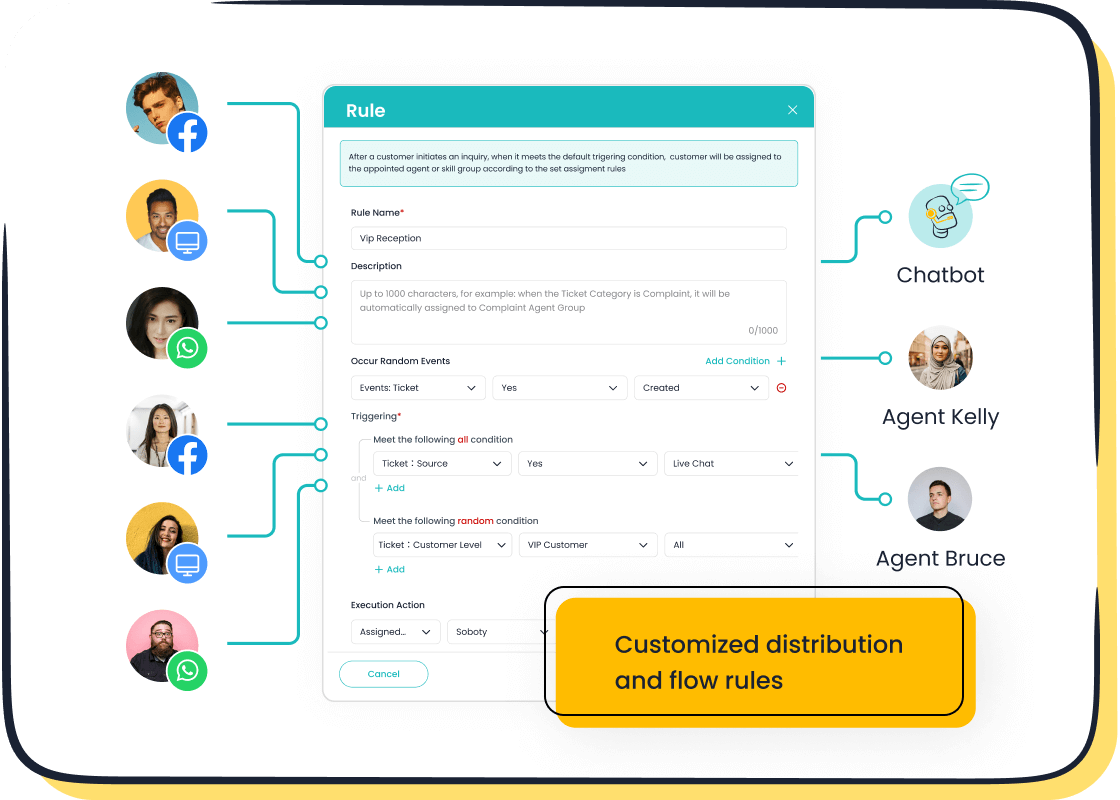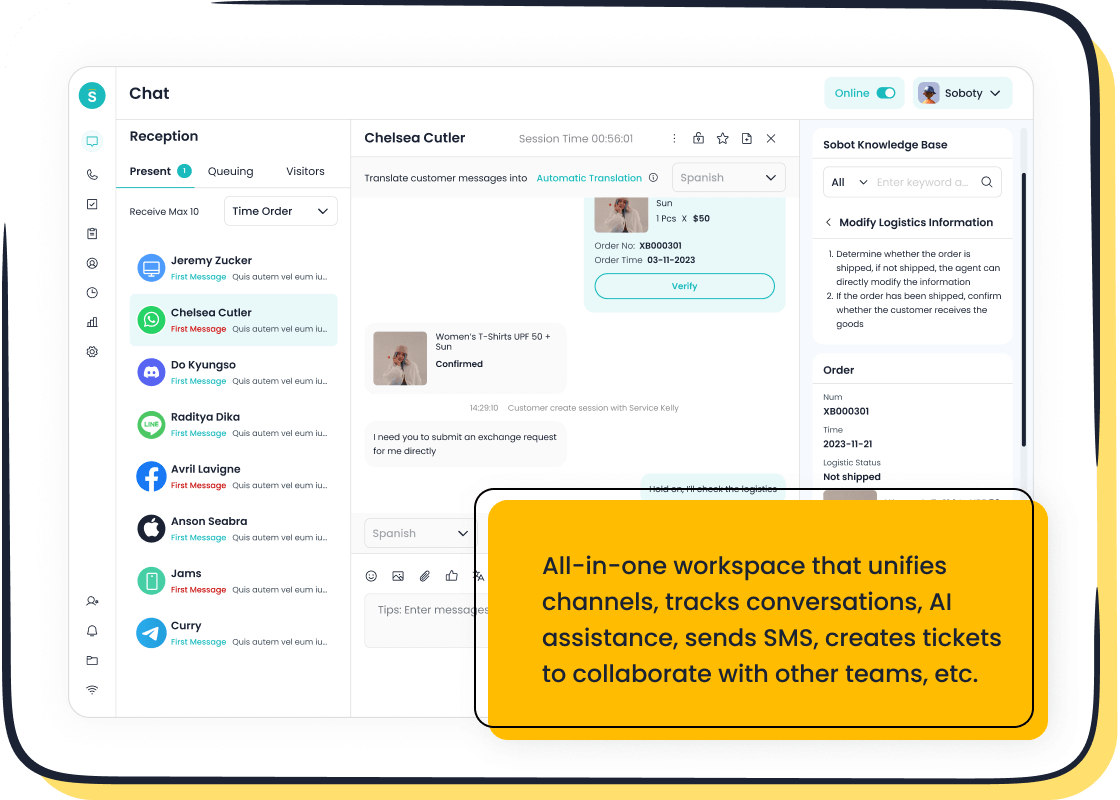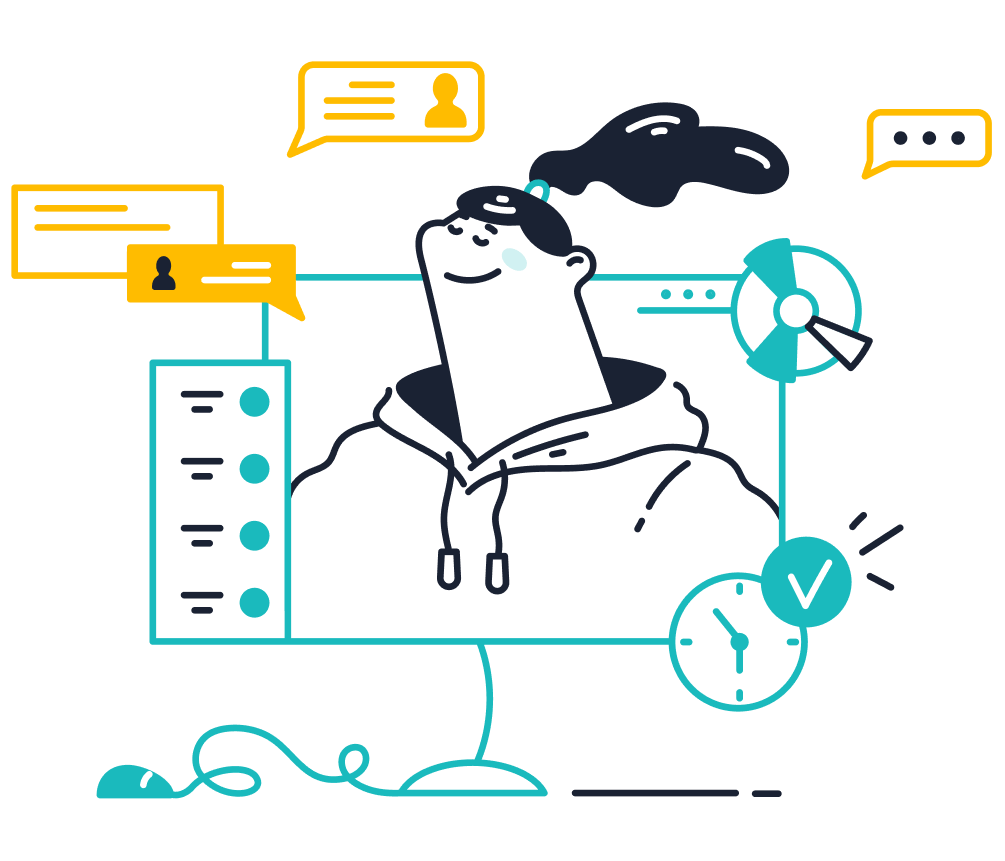Understanding Proactive Support and Its Importance

Proactive support represents a forward-thinking approach to customer support. Instead of waiting for problems to arise, you anticipate potential issues and address them early. This proactive approach not only enhances customer satisfaction but also builds loyalty and trust. For instance:
- 67% of customer churn could be avoided if issues were resolved during the first interaction.
- 91% of dissatisfied customers leave without complaining, making early intervention crucial.
- A 5% increase in retention rates can boost profits by 25-95%.

By investing in proactive strategies, like Sobot's advanced tools, you can reduce operational costs while delivering exceptional service.
What Is Proactive Support in Customer Service?

Definition and Key Characteristics
Proactive customer service focuses on anticipating customer needs and addressing issues before they arise. Unlike traditional reactive models, proactive support emphasizes prevention and early intervention. For example, notifying customers about potential delays or technical glitches builds trust and reduces frustration.
Key characteristics of proactive customer support include:
- Transparency and honesty in communication.
- Timely solutions, such as refunds or discounts, when necessary.
- Keeping customers informed about actions taken to resolve their concerns.
- Engaging with customers on platforms like WhatsApp or Instagram for quick responses.
By adopting these practices, you can enhance customer satisfaction and loyalty while minimizing downtime and operational inefficiencies.
How Proactive Support Differs from Reactive Support
Proactive customer service prevents problems, while reactive support addresses them after they occur. Proactive strategies focus on predicting future outcomes and identifying growth opportunities. Reactive approaches, on the other hand, assess past performance and operational inefficiencies.
Proactive metrics, such as customer retention rate and first contact resolution (FCR), highlight the effectiveness of early intervention. For instance, FCR measures how well your team resolves issues during the first interaction, a critical aspect of proactive support. In contrast, reactive metrics like sales revenue and customer churn rate reflect the consequences of unresolved problems.
By shifting to proactive support, you reduce long-term costs and improve customer satisfaction. Enhanced team productivity allows your agents to focus on complex issues, further boosting response times and service quality.
Examples of Proactive Customer Support in Action
Many companies have successfully implemented proactive customer service strategies. For instance:
- Amazon predicts customer orders with anticipatory shipping, reducing delivery times.
- Apple uses advanced diagnostics tools to identify and address device issues early.
- Tesco Mobile saved $875,000 and reduced inbound calls by 28% within seven months by deploying an online support agent.
- Anglian Water proactively informs customers about outages, improving communication and reducing call volume.

Sobot’s Live Chat platform exemplifies proactive support by enabling businesses to engage with customers across multiple channels. Its AI-assisted tools and built-in analytics help agents anticipate customer needs and provide timely solutions. With features like customer segmentation and satisfaction surveys, Sobot empowers you to deliver exceptional service while fostering loyalty.
Why Proactive Customer Support Matters
Enhancing Customer Satisfaction and Loyalty
Proactive customer service plays a vital role in improving customer satisfaction and loyalty. When you anticipate customer needs and address potential issues early, you create a seamless customer experience. For example, sending reminders about upcoming subscription renewals or notifying customers about service outages demonstrates care and builds customer trust. These actions show that you value their time and concerns.
Satisfied customers are more likely to remain loyal to your brand. Studies reveal that retaining existing customers costs five times less than acquiring new ones. Moreover, loyal customers often become advocates, sharing positive experiences with others. By adopting a proactive approach, you not only enhance customer satisfaction but also reduce customer churn and foster long-term loyalty.
Reducing Costs and Improving Efficiency
Proactive customer care can significantly reduce operational costs while improving efficiency. Addressing issues before they escalate minimizes the need for extensive support interventions. For instance, using tools like Sobot Live Chat allows you to resolve common queries quickly through AI-powered chatbots. These chatbots handle repetitive tasks, freeing up your agents to focus on complex problems.
Additionally, proactive customer service reduces the volume of inbound inquiries. When customers receive timely updates or solutions, they are less likely to contact support teams. This streamlined process saves time and resources, enabling your business to operate more efficiently. By investing in proactive support, you can achieve higher productivity and lower costs simultaneously.
Strengthening Brand Reputation Through Proactive Customer Service
Proactive customer service enhances your brand's reputation by building trust and credibility. Effective communication and timely engagement show customers that you prioritize their needs. For example, monitoring online reviews and responding promptly to feedback demonstrates your commitment to improving customer experiences.
Brands that actively engage with their customers often enjoy higher retention rates and stronger credibility. Regularly addressing concerns and providing solutions fosters a positive image, encouraging customers to return. A strong reputation not only attracts new customers but also strengthens relationships with existing ones. By focusing on proactive customer care, you can build customer trust and establish your brand as a reliable and customer-centric organization.
How to Implement Proactive Support Effectively

Leveraging Technology and Tools Like Sobot Live Chat
Technology plays a crucial role in implementing proactive customer service. Tools like Sobot Live Chat enable you to engage with customers across multiple channels, such as websites, apps, and social media platforms. This omnichannel capability ensures you meet customers where they are, providing seamless and timely support.
Sobot Live Chat uses AI-powered tools to anticipate customer needs and deliver proactive assistance. For example, its built-in analytics evaluates over 150 indicators, helping you identify trends and address potential issues before they escalate. By automating repetitive tasks, such as answering FAQs, the platform frees up your team to focus on complex problems. Over time, this reduces inbound inquiries by up to 20% while improving customer satisfaction rates to over 95%.
Metrics like first contact resolution (FCR) and average response time validate the effectiveness of proactive communication. Faster responses and higher FCR rates indicate that your team resolves issues efficiently, enhancing the overall customer experience.
Using Customer Feedback to Anticipate Needs
Customer feedback offers valuable insights into emerging trends and concerns. By analyzing this data, you can anticipate customer needs and refine your customer service strategy. Tools like AI-powered sentiment analysis and topic modeling help you identify recurring themes in feedback, enabling you to address issues proactively.
For instance, tracking metrics like Net Promoter Score (NPS) and Customer Satisfaction (CSAT) scores reveals how well your proactive customer care efforts resonate with customers. A rising NPS indicates that customers are more likely to recommend your brand, while higher CSAT scores reflect improved satisfaction levels.
Sobot’s solutions simplify feedback analysis by integrating customer data into a unified workspace. This allows you to monitor trends and implement proactive help solutions effectively. For example, if feedback highlights delays in order processing, you can notify customers in advance and offer solutions, demonstrating a customer-centric approach.
Empowering Teams with Training and Resources
Your team’s ability to deliver proactive customer service depends on their training and resources. Empowering them with the right tools and knowledge ensures they can anticipate customer needs and provide timely solutions.
Targeted training programs close skills gaps and align your team’s capabilities with business goals. For example, teaching agents how to use Sobot’s AI-driven tools enhances their efficiency and confidence. Metrics like reduced turnover rates and increased engagement validate the success of these initiatives.
Providing resources like knowledge bases and real-time analytics further supports your team. Sobot’s unified workspace consolidates customer data, enabling agents to access information quickly and resolve issues effectively. This streamlined approach not only boosts productivity but also improves the customer experience by ensuring accurate and timely responses.
Monitoring and Analyzing Customer Behavior for Insights
Understanding customer behavior is essential for delivering proactive support. By analyzing customer interactions, you can identify patterns, predict needs, and address potential issues before they arise. This approach not only improves customer satisfaction but also enhances operational efficiency.
Behavioral analysis empowers your team to deliver personalized support. For instance, tracking customer preferences helps you tailor solutions that resonate with their needs. It also enables you to anticipate common issues, such as seasonal ticket surges, and prepare your team accordingly. This proactive approach strengthens customer relationships and builds trust.
To measure the effectiveness of proactive support, you can rely on key performance metrics. The table below highlights some essential metrics:
| Metric Type | Description |
|---|---|
| Customer Satisfaction (CSAT) | Measures performance and identifies areas for improvement across the organization. |
| Real-time vs Historical Analytics | Differentiates when to use various analytics for better decision-making in support strategies. |
| Descriptive Analytics | Recognizes trends that can inform future strategies, such as seasonal ticket increases. |

Using tools like Sobot Live Chat simplifies this process. Its built-in analytics evaluates over 150 indicators, helping you monitor customer behavior in real time. For example, you can track first contact resolution rates to ensure your team resolves issues efficiently. Metrics like agent productivity and SLA attainment rates further validate the success of your proactive strategies.
By leveraging these insights, you can refine your customer service approach. For example, if analytics reveal a spike in inquiries about a specific product, you can proactively address concerns through FAQs or chatbot updates. Sobot’s unified workspace consolidates customer data, enabling your team to act quickly and effectively.
Monitoring customer behavior not only enhances service quality but also reduces costs. When you anticipate customer needs, you minimize the volume of inbound inquiries, allowing your team to focus on complex issues. This strategy ensures a seamless customer experience while fostering loyalty and trust.
Real-World Examples of Proactive Customer Service

Sobot’s Role in Enhancing Proactive Support for Clients

Sobot has revolutionized how businesses deliver proactive customer service by offering tools that anticipate customer needs and streamline interactions. Its solutions, such as AI-powered chatbots, live chat, and ticketing systems, empower you to address issues before they escalate. These tools not only improve efficiency but also enhance customer satisfaction.
For example, Sobot’s chatbot automates routine inquiries, providing 24/7 support. This reduces the workload on your team and ensures customers receive timely assistance. The live chat feature connects customers with human agents for complex issues, offering personalized support. Additionally, the ticketing system organizes and resolves customer requests efficiently, improving response times.
| Feature | Description | Impact on Proactive Support |
|---|---|---|
| Voice | AI-powered assistance for handling customer calls. | Enhances efficiency in customer interactions. |
| Chatbot | Automates routine inquiries and provides 24/7 support. | Increases customer satisfaction and operational efficiency. |
| Livechat | Connects customers with human agents for complex issues. | Offers personalized support quickly. |
| Ticketing | Automates management and resolution of customer requests. | Improves organization and response times. |
These features demonstrate how Sobot equips you with the tools needed to deliver exceptional proactive customer service.
Case Study: OPPO’s Success with Sobot Solutions
OPPO, a global leader in smart devices, partnered with Sobot to enhance its customer service capabilities. During peak shopping periods, OPPO faced challenges like high inquiry volumes and long wait times. By implementing Sobot’s chatbot and ticketing system, OPPO transformed its support operations.
The chatbot resolved 83% of inquiries, allowing human agents to focus on complex issues. This human-machine collaboration improved efficiency and reduced response times. Sobot also optimized OPPO’s knowledge base, cutting maintenance efforts by 90%. As a result, OPPO achieved a 94% positive feedback rate and a 57% increase in repurchase rates.
This case highlights how proactive customer service, powered by Sobot, can drive measurable results. By anticipating customer needs and streamlining processes, OPPO enhanced satisfaction and loyalty.
Industry Applications of Proactive Customer Support
Proactive customer service benefits various industries by addressing unique challenges and improving customer experiences.
- Retail and E-commerce: Businesses use proactive strategies to notify customers about order delays or stock availability. This reduces inbound inquiries and builds trust.
- Financial Services: AI-driven tools guide customers through complex processes, such as loan applications, ensuring clarity and efficiency.
- Gaming: Support teams resolve player issues faster by analyzing behavioral patterns and addressing common concerns proactively.
| KPI | Description |
|---|---|
| Customer Retention Rate | Measures the percentage of customers who continue to do business with a company over time. |
| Response Time | Measures how quickly a business responds to proactive customer interactions. |
| Customer Lifetime Value | Calculates the total revenue expected from a single customer over their entire relationship. |
| Customer Advocacy | Measures the extent to which customers promote a company's products or services to others. |
Across industries, proactive customer service fosters loyalty, reduces costs, and enhances brand reputation. By leveraging tools like Sobot’s omnichannel solutions, you can deliver seamless and personalized experiences that meet customer expectations.
The Future of Proactive Customer Service
Trends Shaping Proactive Support Strategies
Proactive customer service continues to evolve as businesses adapt to changing consumer expectations and technological advancements. Research shows that nearly one-third of IT and CX leaders anticipate a shift from inbound interactions to proactive outreach by 2025. This trend reflects the growing importance of addressing customer needs before they arise.
Several factors drive this transformation:
- AI and Analytics: Companies increasingly rely on predictive analytics to anticipate customer behavior and optimize service delivery. For example, Nike enhanced online engagement during the COVID-19 pandemic, boosting sales and customer satisfaction.
- Customer Expectations: Studies reveal that 92% of customers positively change their perception of a company after receiving proactive outreach. This highlights the importance of proactive strategies in building trust and loyalty.
- Industry Adoption: Currently, 59.7% of organizations engage in proactive outreach, with 47.1% leveraging AI to enhance their efforts.
These trends underline the need for businesses to embrace proactive customer service as a core strategy to stay competitive in the evolving market.
The Role of AI and Automation in Proactive Customer Service
AI and automation are revolutionizing proactive customer service by enabling businesses to predict and address customer needs efficiently. AI-powered chatbots, for instance, are projected to save companies over $11 billion annually by 2025. These tools reduce call volumes by up to 30% and cut service costs by 25%, making them invaluable for modern customer support.
Predictive analytics further enhances proactive strategies. By analyzing historical and real-time data, AI identifies trends and anticipates customer needs. For example, it can foresee IT issues and resolve them before they impact users. This data-driven approach improves customer satisfaction and reduces churn.

Sobot’s solutions integrate AI and automation seamlessly into customer service operations. Its omnichannel platform consolidates customer interactions across channels, enabling agents to provide timely and personalized support. Features like AI-driven chatbots and built-in analytics empower your team to deliver exceptional proactive service while optimizing efficiency.
How Sobot’s Omnichannel Solutions Drive Proactive Support
Sobot’s omnichannel solutions redefine proactive customer service by unifying communication channels and leveraging advanced technologies. The platform enables businesses to engage with customers on their preferred channels, such as social media, websites, and apps, ensuring seamless interactions.
Key benefits of Sobot’s solutions include:
- Efficiency Gains: The platform reduces response times by 80% and boosts agent efficiency by 20%, as shown in recent metrics.
- Personalized Support: AI-powered tools analyze customer data to deliver tailored solutions, enhancing satisfaction and loyalty.
- Proactive Insights: Built-in analytics track customer behavior, allowing you to anticipate needs and address issues early.
By adopting Sobot’s omnichannel solutions, you can transform your customer service approach, fostering trust and loyalty while reducing operational costs. Learn more about Sobot’s offerings here.
Proactive support transforms how you engage with customers by addressing their needs before issues arise. This approach enhances customer satisfaction, builds loyalty, and reduces operational inefficiencies. For instance, businesses with high proactive service scores outperform others by 30 points in overall functionality and development metrics.
Adopting proactive customer service strategies ensures you stay competitive in today’s fast-paced market. Over 85% of customers prefer proactive communication, and addressing concerns early fosters trust and loyalty. Tools like Sobot Live Chat simplify this process by offering omnichannel support, AI-driven insights, and real-time analytics. These features empower your team to deliver exceptional proactive customer care while optimizing efficiency.
By embracing the benefits of proactive customer service, you can elevate your brand reputation, improve retention rates, and drive long-term growth.
FAQ
What is proactive customer support?
Proactive customer support anticipates and resolves issues before they arise. For example, notifying customers about service delays or offering solutions to common problems builds trust. Tools like Sobot Live Chat help businesses implement this approach by providing real-time insights and AI-driven assistance.
How does proactive support improve customer satisfaction?
Proactive support shows customers you care about their needs. For instance, sending reminders about subscription renewals or addressing potential issues early reduces frustration. Studies reveal that 92% of customers appreciate proactive outreach, which positively impacts their perception of your brand.
Can small businesses implement proactive customer service?
Yes, small businesses can adopt proactive strategies using tools like Sobot Live Chat. Features like AI-powered chatbots and built-in analytics simplify customer engagement. These tools reduce costs and improve efficiency, making proactive support accessible for businesses of all sizes.
What role does AI play in proactive customer service?
AI predicts customer needs by analyzing data and trends. For example, Sobot’s AI-driven chatbots handle repetitive queries, freeing agents to focus on complex issues. This approach improves response times, reduces costs, and enhances customer satisfaction.
How can Sobot help with proactive customer support?
Sobot offers tools like Live Chat and omnichannel solutions to streamline proactive support. These tools consolidate customer interactions, provide real-time analytics, and automate repetitive tasks. By using Sobot, you can enhance customer satisfaction and reduce operational inefficiencies.
See Also
Harnessing Depop's Live Chat For Fast Customer Assistance
Enhancing SaaS Customer Service Through Live Chat Techniques
Excelling In Live Chat To Improve Customer Assistance
AI-Powered Customer Service Agents Transform Support Experience
Around-The-Clock Live Chat Assistance Drives Business Growth